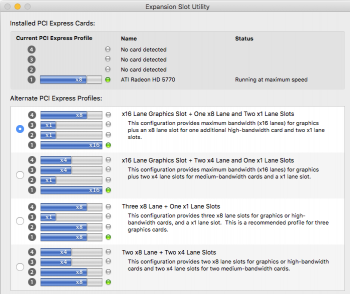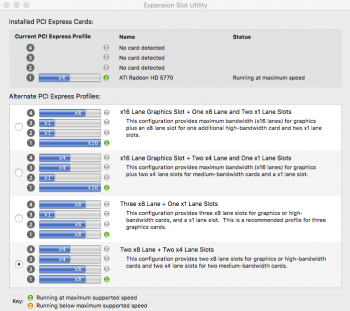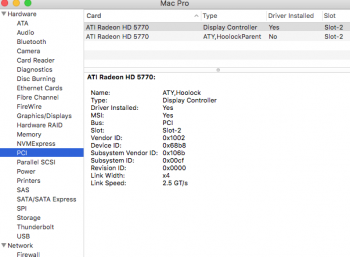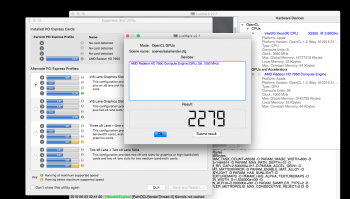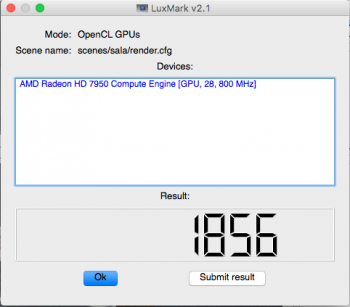Hi rthpjm,
Only too glad to post steps which led to my current configuration, specially if it helps you and others to keep these lovely old MacPros running. Mine is a 1.1 with 2 x 2 GHz dual core Intel Xeon processors, 10 GB DRAM, an NVIDIA GeForce GT120 512 MB video card from MacVid, and a 120 GB SSD from OWC.
In January 2016, I installed OS X 10.11.2 using Piker-Alpha's boot.efi files in place of the Apple files. I followed your procedure in posts #1390 and #1391 of this thread, and checked that your Boot64v3 was properly installed. Everything worked beautifully, and I had no problems with just 10 GB of DRAM. When updates 10.11.3 and 10.11.4 were released, I downloaded and installed them straight from the App Store without problems. But after using the same procedure for 10.11.5, the update installed but wouldn't boot.
1 Sure enough, this last update had overwritten the Piker-Alpha boot.efi files with new Apple files.
2 I manually deleted the Apple boot.efi files and replaced them with the P-A files in the S/L/CoreServices and usr/standalone/i386 folders. I also had to add again my video card details in the PlatformSupport.plist.
3 After this, the MacPro boots successfully into OS X 10.11.5. I'm using it now for this post.
4 So, thinking that the Boot64v3 script wasn't doing its job of rewriting the boot.efi files overwritten by the standard Apple update, I reverted to your post #1391 to check. "Operation Not Permitted" was the return in Terminal to the code "touch /S/L/CS/boot.efi". Therefore I assumed that Boot64v3 wasn't working.
5 Next I tried to reboot from the Recovery Partition, as per post #1391, without success - there was NO Recovery Partition! A quick Forum search suggested reinstalling OS X 10.11.5 would create a Recovery Partition.
6 Using a bootable 10.11.5 USB drive to reinstall OS X did not create a Recovery Partition on the SSD drive. Further, there was no Recovery Partition on the bootable USB drive either.
7 I managed to create a RP on the USB drive by using Chris Silvertooth's Create Recovery Partition v 4.x. However, I could not boot from this RP.
8 So I used the same script to successfully create a 650 MB RP on the SSD. This RP is visible in Terminal (diskutil list) and in Disk Utility, and on the start-up screen after holding Command + R during booting. As I said in my reply to Ant3000 in post # 2314, booting seems to be initiated from the Recovery Partition, but then continues a normal boot through to completion. I definitely do not get the normal Recovery screen with its Disk Utility/Internet Recovery/Time Machine etc options.
9 Right now I'm about to bless the appropriate /Volumes/SSDName folder and files as suggested by you and Lancebroyles in posts #2324 and #2325.
But I'm going to wait for any response you might have to all of the above before doing so. Thanks in anticipation!
Hi rdfincher,
I keep using the caveat that Apple are still developing SIP, and as it develops it will probably break Boot64!

I had some trouble from 10.11.1 to 10.11.2 ( I think I figured it out and fixed it )
I also had some trouble from .3 to .4 ( I didn't really investigate here )
Finally, .4 to .5 I had the same experience as you. ( I haven't had time to investigate yet )
I "think" that .3 to .4 was simply that the "flags" ( as in chflags ) still had the user change flag set (uchg), which uninutatively means users are not allowed to change the file (compared with nouchg, which means users are allowed to change the file!).
I "think" that .4 to .5 may have completely broken the Boot64 technique (.4 probably introduced something, it only becomes apparent when the next upgrade came along). I'll investigate further, but it looks like the Sandbox exclusion is not being honoured, so the /S/L/C/boot.efi remains protected by SIP.
Boot64 will continue to operate if you completely disable SIP. Of course to do this you need a Recovery partition!
Thanks for the "how I got here" list. It hasn't really helped though!

I remain confused, if you followed #1390, then you should have a recovery partition. It's just odd.
There's probably no point going down that road any further, "you are where you are"....
The symptoms you describe are a common effect. When booting into the recovery partition, it's a two-stage process.
Stage 1 boots using the boot.efi file found at /Volumes/Recovery HD/com.apple.recovery.boot/
There are a number of files in that folder including a BaseSystem disk image (it's hidden in the Finder)
Stage 1 is set up to create some RAM disks which are populated from the BaseSystem
Stage 2 sees the initial boot-from-disk hand over to to the newly created RAM-disks (effectively a soft reboot)
This usually means that you have to replace the boot.efi files in both the Recovery HD, and the BaseSystem disk image in order to boot into the Recovery environment.
If the boot.efi is replaced in just the com.apple.recovery.boot folder but not in the BaseSystem disk image, you will usually experience your symptoms. As stage 1 hands over to stage 2, that second boot.efi copy is not correct so the stage 2 boot fails. The firmware reverts back to its "search for a bootable partition" mode which will usually find your main Mac OS X partition as the first candidate, it boots from that.
I'm not familiar with the script you referred to that builds a recovery partition, I can't comment on its results.
My #1390 pikify method takes all this into account. The USB install media is already modified to put the Pike R Alpha boot.efi files into the right places. When the (Apple) installer runs it creates a Recovery HD partition first, it copies the BaseSystem.dmg from the USB stick which is already modified with the PA boot.efi, it also copies the boot.efi file from the USB stick into the com.apple.recovery.boot folder (which of course is also the PA version on the USB stick already). Therefore the Recovery HD is correct if you use the #1390 pikify method.
Note: the 10.11.2 update had a Recovery partition upgrade embedded, one of the files the RHD upgrade replaced was the boot.efi file in com.apple.recovery.boot. It didn't replace the BaseSystem.dmg. To fix the 10.11.2 RHD you need to put the PA boot.efi file back into com.apple.recovery.boot.
Because lots of people use the alternative method of installing El Capitan, by connecting their MacPro disk to a newer supported Mac running the installer from there, they end up with an install and Recovery HD that has Apple boot.efi files in all locations. Whilst most people know to replace the boot.efi files in the main OS partition they often don't know what to do to get the RHD working. That's why I wrote the rrhd script....



